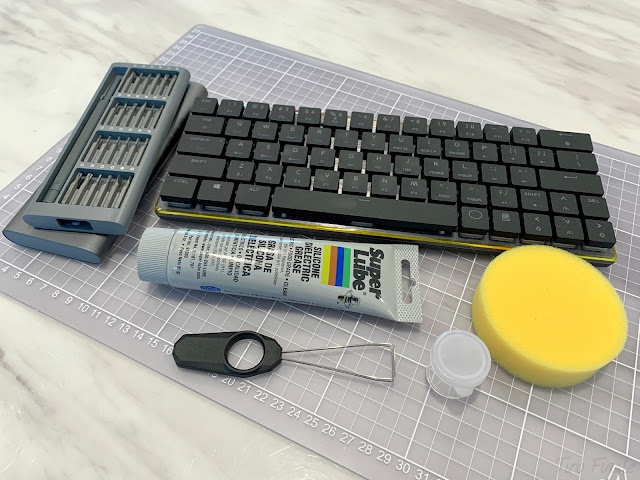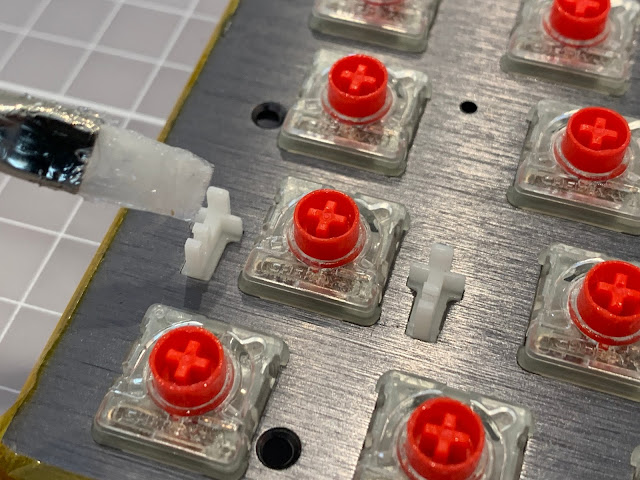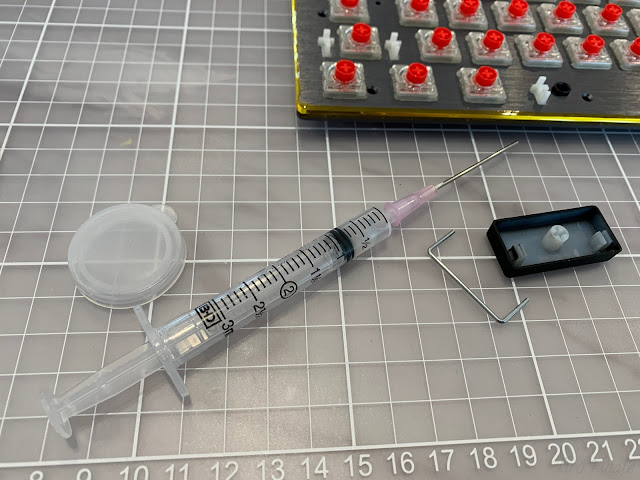Modding My: Cooler Master SK621
Hello everyone and welcome back to Tiro Finale. Today, we will be doing something a little unusual from our regularly schedule content her on Tiro Finale. Those of you who have read the blog would have probably realized that aside from anime, figure and photography, I also have a pretty big interest in all thing computers. And since my schooling years, I have always had a profound interest in input peripherals initially mice and then, moving onto keyboards. Having collected several mechanical keyboards over the past years, I have decided to take the leap down the rabbit hole into the world of enthusiasts mechanical keyboards. Since my Ducky One 2 SF was currently taking full time duty as my daily, I figured it was high time to apply some mods to my beloved Cooler Master SK621.
The first order of business was to remove the key caps and stow them away at a safe place. Because the key caps on the SK621 are of the low profile variant, they fit easily into these cute little plastic containers. Yes, the SK621 does indeed use laser engrave ABS keycaps and has been a large point of contention and criticism for this family of keyboards. The good news is that Cooler Master have offered to send a full set of brand new key caps for all early adopters of the SK series keyboards. Not only are these new key caps sculpted in a more ergonomic profile, they are also made of PBT. If you own an SK series keyboard, make sure you check out the replacement program.
Now, back onto the keyboard itself. With the key caps removed, I set aside some time to clean up the top plate off any dust and debris using a small paint brush. The SK series of keyboards use Cherry's MX low profile mechanical switches which are currently only available in linear switches hence, the red stems. I will be going into the whole process of lubricating them in a bit.
But first, we will have to take apart the keyboard. Taking a lot of care to make sure when separating the case from the PCB and top plate to not rupture the two battery cells located in the case. These batteries power the SK621 when in wireless Bluetooth mode and provide a decent amount of juice even with the RGB lights on.
There are four connectors in total that need to be detached before the top and bottom are separated. These are the two connectors for the batteries, one for the power switch and another for the USB C controller. I had to remove the entire USB C PCB as it was connected a little too tightly on the actual PCB of the keyboard. Props to Cooler Master for separating the battery cells in order to keep the weight of the keyboard more balance.
The reason why I removed the top plate and the bottom case is to fill the empty case with some foam. This is a mod that I have always wanted to try out. It helps to dampen any vibration and reverberation when bottoming out during typing while also helping to add to make the entire board feel more dense. This in return helps to reduce the "hollow" sound you would often get from keyboard especially the full sized ones with plastic cases.
With the foam filling done, it was time to get cracking with switch lubrication. The SK621 does not have hot swap switches nor did I have any intention of de-soldering them. Rather than taking apart the switch, I was going to take a different approach and hoped that this would work out.
Because the MX Low Profile Reds (and Silvers) use a circular stem housing not unlike the square stem housings of Kailh Box switches, I figured it would be worth a shot lubricating the outside of the stems. In theory, this would help to lubricate the contacts between the stems and the edges of the upper housing. The lubricant that I would be using is Super Lube's dielectric grease. It is no Crytox lubricant but, with an almost similar chemical compound at a much cheaper price point it felt like a better choice on a first project.
Of course, I am aware that this does not actually lubricate the contacts off the actual switch itself. In return, what I did was lubricate the first few top row keys and compared them with the stock bottom row keys. The difference was immediately noticeable with a stark reduction in the "scrathiness" that came with the original keys. After sixty plus keys, the lubrication job was done and it was time to move on to the stabilizers.
The stabilizers employed by the SK series keyboards are wire stabilizers which is something of a staple from Cooler Master at this point. While I do prefer Cherry type stabilizers, these are actually a little easier to work on in terms of lubrication as the points of contact are much more visible.
I only needed to apply a small amount of lubricant on the stabilizer housings which came in contact with the wires. This is where using a 3 ml syringe was very helpful in dispensing a small volume of lubricant.
It is almost a day and night difference between the lubricated and standard stabilizers with the rattle associated with the wire stabilizers being completely eliminated.
Some of the screws were located underneath the longer modifier keys and so I needed to put the top plate and case back together first before moving on with the installation and lubrication of the space bar.
Better yet, I finally got rid of the rattling space bar which has always been one of my biggest gripes about this keyboard. Now that it is gone, I finally look forward to typing on it once more.
With the switches and stabilizers lubricated, case filled with foam and screws securely tightened, I flicked the power switch on and was greeted with the good news that was the RGB rainbow. I have not, for now at least, messed up any step of this modification process. The next step was to then install the key caps back and test out each individual key to make sure they were working fine.
With all of the keys reinstalled, I tested each individual key comparing them with another to make sure each was adequately lubricated. Those that were not, were taken apart and given another coat of lubrication before being tested again. With everything in order, it was time to take this keyboard for a test drive and what better way to do that then by using it to type this article.
What started out as a little experiment in curiosity turned out to be one of the most satisfying projects I have done in a long time as it truly elevated the SK621 to the next level. The switches are notably smoother and the stabilizers are completely silent leaving for a much improved typing experience and this is coming from someone who is not normally a fan of linear switches. The next part of this project would be the replacement PBT keycaps which would really help seal the deal on this being a real keeper in the collection.
With that, I will leave you with a final video of the the tying test to let you decide if these mods were truly worth it. If you would like to see more content like this, do let me know in the comments sections below as I already have several new keyboards, switches and key caps on the way including one very special one from Japan. Until the next time, thank you so much for reading and have yourself a wonderful day ahead!
The first order of business was to remove the key caps and stow them away at a safe place. Because the key caps on the SK621 are of the low profile variant, they fit easily into these cute little plastic containers. Yes, the SK621 does indeed use laser engrave ABS keycaps and has been a large point of contention and criticism for this family of keyboards. The good news is that Cooler Master have offered to send a full set of brand new key caps for all early adopters of the SK series keyboards. Not only are these new key caps sculpted in a more ergonomic profile, they are also made of PBT. If you own an SK series keyboard, make sure you check out the replacement program.
Now, back onto the keyboard itself. With the key caps removed, I set aside some time to clean up the top plate off any dust and debris using a small paint brush. The SK series of keyboards use Cherry's MX low profile mechanical switches which are currently only available in linear switches hence, the red stems. I will be going into the whole process of lubricating them in a bit.
But first, we will have to take apart the keyboard. Taking a lot of care to make sure when separating the case from the PCB and top plate to not rupture the two battery cells located in the case. These batteries power the SK621 when in wireless Bluetooth mode and provide a decent amount of juice even with the RGB lights on.
There are four connectors in total that need to be detached before the top and bottom are separated. These are the two connectors for the batteries, one for the power switch and another for the USB C controller. I had to remove the entire USB C PCB as it was connected a little too tightly on the actual PCB of the keyboard. Props to Cooler Master for separating the battery cells in order to keep the weight of the keyboard more balance.
The reason why I removed the top plate and the bottom case is to fill the empty case with some foam. This is a mod that I have always wanted to try out. It helps to dampen any vibration and reverberation when bottoming out during typing while also helping to add to make the entire board feel more dense. This in return helps to reduce the "hollow" sound you would often get from keyboard especially the full sized ones with plastic cases.
With the foam filling done, it was time to get cracking with switch lubrication. The SK621 does not have hot swap switches nor did I have any intention of de-soldering them. Rather than taking apart the switch, I was going to take a different approach and hoped that this would work out.
Because the MX Low Profile Reds (and Silvers) use a circular stem housing not unlike the square stem housings of Kailh Box switches, I figured it would be worth a shot lubricating the outside of the stems. In theory, this would help to lubricate the contacts between the stems and the edges of the upper housing. The lubricant that I would be using is Super Lube's dielectric grease. It is no Crytox lubricant but, with an almost similar chemical compound at a much cheaper price point it felt like a better choice on a first project.
Of course, I am aware that this does not actually lubricate the contacts off the actual switch itself. In return, what I did was lubricate the first few top row keys and compared them with the stock bottom row keys. The difference was immediately noticeable with a stark reduction in the "scrathiness" that came with the original keys. After sixty plus keys, the lubrication job was done and it was time to move on to the stabilizers.
The stabilizers employed by the SK series keyboards are wire stabilizers which is something of a staple from Cooler Master at this point. While I do prefer Cherry type stabilizers, these are actually a little easier to work on in terms of lubrication as the points of contact are much more visible.
I only needed to apply a small amount of lubricant on the stabilizer housings which came in contact with the wires. This is where using a 3 ml syringe was very helpful in dispensing a small volume of lubricant.
Some of the screws were located underneath the longer modifier keys and so I needed to put the top plate and case back together first before moving on with the installation and lubrication of the space bar.
With the switches and stabilizers lubricated, case filled with foam and screws securely tightened, I flicked the power switch on and was greeted with the good news that was the RGB rainbow. I have not, for now at least, messed up any step of this modification process. The next step was to then install the key caps back and test out each individual key to make sure they were working fine.
With all of the keys reinstalled, I tested each individual key comparing them with another to make sure each was adequately lubricated. Those that were not, were taken apart and given another coat of lubrication before being tested again. With everything in order, it was time to take this keyboard for a test drive and what better way to do that then by using it to type this article.
With that, I will leave you with a final video of the the tying test to let you decide if these mods were truly worth it. If you would like to see more content like this, do let me know in the comments sections below as I already have several new keyboards, switches and key caps on the way including one very special one from Japan. Until the next time, thank you so much for reading and have yourself a wonderful day ahead!
















I have one coming and can't wait! Where do you buy your keycaps for this though? Looking forward on the next part of this project for the replacement of the PBT keycaps.
ReplyDeleteUnfortunately, there aren't any suitable aftermarket keycaps for this keyboard except for the PBT ones that Cooler Master have released.
Delete